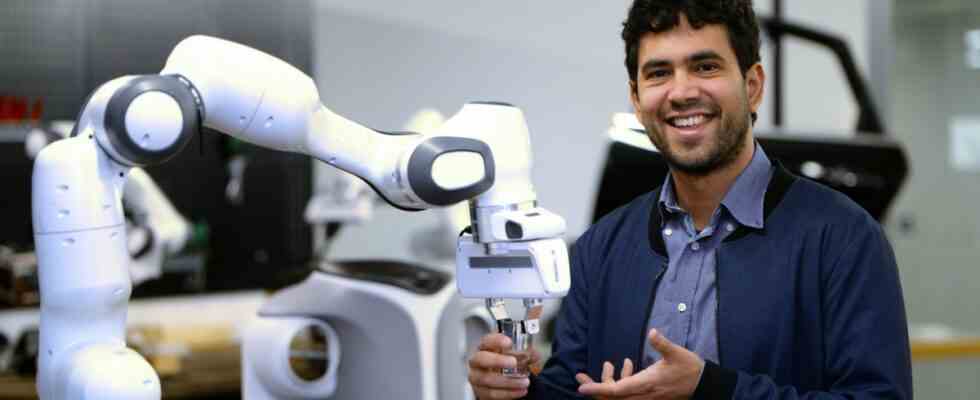Luis Figueredo fills a glass to the brim with tea and puts it on the robot’s “hand”. He swings it back and forth, up and down, without spilling a drop – nobody could do it that well. The Brazilian came up with the idea late one evening in the lab, while sitting with doctoral student Riddhiman Laha from India and master’s student Rafael Cabral Muchacho from Spain, and one of the three spilled his coffee. Figueredo did his doctorate in Brasilia, did research at the Massachusetts Institute of Technology and in Great Britain and came to Munich three years ago to join the team of Sami Haddadin, who heads the Munich Institute of Robotics and Machine Intelligence (MIRIM) at the Technical University. Your waiter robot now made the professional world sit up and take notice.
We know that robots are better at chess than humans, that they talk, paint, assemble cars and assist in the operating room. Why is your fake waiter such a sensation?
It sounds simple, but the task of serving drinks without spilling a drop while being responsive to the environment was a huge challenge. Our robot can do that, more precisely and faster than a human.
For real?
The reaction time of a human to visual stimuli is more than 100 milliseconds, our robot reacts in less than one millisecond. Imagine that it is used in a nursing home – one of the possible applications – and is supposed to serve hot soup to a patient. Then the patient suddenly says: I don’t want that and makes a dismissive hand gesture. Then the robot has to retreat at lightning speed without spilling a drop.
Surely scientists around the world are researching this task?
Yes, but so far this stability has not been achieved, especially not in real time. The computing time for the movements and reactions was far too long. We were at a conference in Japan recently with 4000 of the best robotics researchers in the world. We told them: try everything you can think of to unbalance our robot. And they really tried! But nobody succeeded. Now we have to work even more on security so that it can anticipate human movements even better.
How did you come up with the idea?
We were sitting in the lab late one night again, all already tired, and one of my students spilled his coffee. We fooled around and said: Maybe the robot should bring the coffee. Then we started tinkering. When we got down to the Moroccan tea tray, we found the solution pretty quickly. In Japan, a number of colleagues now said to us: Oh my God, why didn’t we think of it ourselves?
What did you do differently and what does the Moroccan tea tray have to do with it?
Sometimes you can’t think too complicated. Many researchers have tried to model the liquids in the glass, which is an infinitely complex task. We saw this video of a Moroccan tea carrier whose tray oscillates according to the principle of the spherical pendulum, i.e. allows deflections in different directions. If you understand the 300-year-old mathematical principle behind it, you can program it, then it’s suddenly quite easy.
Does the robot have a name?
No, we started with Franka Emika’s robots, which were developed here in Munich at the institute and are now in use worldwide. But we keep testing our program on different robots.
Can he or she speak?
We are in the process of integrating language. Simple questions and answers are easy to program. But natural language, which a care robot would have to understand, for example, is a greater challenge. It’s always about patient safety. We are already working with other research groups on this, and I don’t think it will be long before we can do that too.
What suggestions do you get from practice?
We are in talks with nursing schools to learn what scenarios occur there in everyday life. The nursing shortage is one of the greatest social challenges, the assistance with the food distribution would be a great help. But we have also spoken to chemical laboratories and a film company that would like to use the robot. That’s what makes the job so exciting: You deal with very different people and disciplines. I talk to medical professionals, mechanics, sociologists, psychologists, anthropologists. And learn something new every time.
And now you let the robot serve you coffee every day in the office?
unfortunately not (laughs). He’s over there in the laboratory and constantly has to deal with new research tasks. He doesn’t have much time to serve.

